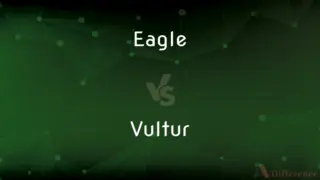U Shaped Valley vs. V Shaped Valley — What's the Difference?
By Tayyaba Rehman — Published on November 14, 2023
U Shaped Valleys are carved by glaciers and have steep, straight sides with a flat bottom, while V Shaped Valleys are formed by rivers and feature a pointed bottom with sloping sides.

Difference Between U Shaped Valley and V Shaped Valley
Table of Contents
ADVERTISEMENT
Key Differences
U Shaped Valleys, as the term suggests, denote valleys that exhibit a clear, U-shaped contour, created by glacial erosion that enhances the width and often flattens the valley floor, establishing a broad, often visually striking landform. V Shaped Valleys, in contrast, are typically formed by river erosion, wherein the persistent action of a river over time carves a distinct, V-like shape into the landscape, establishing a narrower valley floor and sloped sides that converge at the river itself.
The formation of a U Shaped Valley involves glacial movement, where glaciers move through existing valleys, their immense weight and erosive power effectively broadening and flattening the valley floor, creating those characteristic steep and straight walls. V Shaped Valleys, conversely, are essentially sculpted by rivers, which erode the landscape over time, the continuing flow gradually forming a valley that is pointed at the bottom, the slopes meeting at the very point where the river flows.
U Shaped Valleys, due to their glacial origins, are often associated with regions historically influenced by significant glacial activity, which may be observed in areas like parts of the Alps, where stunning U-shaped contours punctuate the landscape. V Shaped Valleys, however, can often be found in areas where river erosion has been the dominant shaping force, such as in numerous locations in the Appalachian Mountains, where rivers have persistently carved through the terrain.
The bottom of a U Shaped Valley tends to be quite flat and broad, accommodating various landforms such as lakes or wide riverbeds, supporting an array of ecosystems and human activities. V Shaped Valleys, however, with their more narrow and pointed bottom, generally host the river that formed them, the environment typically more constrained and directly influenced by the river's presence and flow.
Observing a U Shaped Valley, one might admire the formidable power of glaciers, considering the sheer physical might required to reform a landscape so dramatically. Gazing upon a V Shaped Valley, there's an invitation to contemplate the cumulative, persistent power of water, which, over time, decisively reshapes the world it flows through, carving deep, lasting channels into the earth.
ADVERTISEMENT
Comparison Chart
Formative Agent
Glacier
River
Typical Cross-section
Broad, flat bottom; steep, straight sides
Pointed bottom; sloping sides
Common Locations
Regions with historic glacial activity
Areas with dominant river erosion
Valley Floor
Generally broad and flat
Typically narrow and pointed
Associated Ecosystems
Can accommodate diverse ecosystems
Often closely tied to the river's ecosystem
Compare with Definitions
U Shaped Valley
A landform created by the erosive action of glaciers.
The U Shaped Valley was left behind by a massive glacier.
V Shaped Valley
Commonly found in areas with persistent river activity.
Numerous V Shaped Valleys adorned the region's geography.
U Shaped Valley
Found in regions with a history of significant glacial activity.
The U Shaped Valley signified the area's icy past.
V Shaped Valley
Characterized by a pointed bottom and sloping sides.
The V Shaped Valley gracefully sliced through the landscape.
U Shaped Valley
Can host a variety of ecosystems and human activities.
The U Shaped Valley is home to a vibrant wildlife population.
V Shaped Valley
Typically contains the river that formed it.
The river snaked along the V Shaped Valley's floor.
U Shaped Valley
Recognizable by its steep, straight sides and flat bottom.
Hiking across the U Shaped Valley provided breathtaking views.
V Shaped Valley
A landform primarily formed by river erosion.
The V Shaped Valley cradled a swift, meandering river.
U Shaped Valley
A prominent feature in many mountainous regions.
Tourists marveled at the expansive U Shaped Valley.
V Shaped Valley
Often becomes a focal point of local ecosystems.
Diverse creatures inhabited the lush V Shaped Valley.
Common Curiosities
What is a distinguishing feature of a U Shaped Valley?
A U Shaped Valley has steep, straight sides and a flat bottom.
Where might you find a U Shaped Valley?
U Shaped Valleys are often found in regions with historical glacial activity.
How can you describe the shape of a V Shaped Valley?
A V Shaped Valley has a pointed bottom with sides that slope inward.
What usually occupies the floor of a V Shaped Valley?
The river that formed the V Shaped Valley typically occupies its floor.
Can you typically traverse the bottom of a U Shaped Valley?
Yes, the flat bottom of a U Shaped Valley is often traversable.
How is a U Shaped Valley formed?
U Shaped Valleys are formed by the erosive action of glaciers.
Can U Shaped Valleys host diverse ecosystems?
Yes, U Shaped Valleys can support varied ecosystems and human activities.
How wide is the floor of a V Shaped Valley typically?
V Shaped Valleys usually have a narrower, pointed valley floor.
Are V Shaped Valleys usually deep or shallow?
V Shaped Valleys can be quite deep, especially with prolonged river activity.
In what environments are V Shaped Valleys typically found?
V Shaped Valleys are common in areas where river erosion is prevalent.
What creates a V Shaped Valley?
V Shaped Valleys are carved by the persistent erosion from rivers.
Is it common to find lakes in a V Shaped Valley?
No, V Shaped Valleys typically host rivers, not lakes.
Is a U Shaped Valley generally wide or narrow?
U Shaped Valleys are generally characterized by a wider, flatter bottom.
Can you find U Shaped Valleys in the Alps?
Yes, U Shaped Valleys are a prominent feature in parts of the Alps.
Can humans inhabit U Shaped Valleys?
Yes, U Shaped Valleys can accommodate human activities and settlements.
Share Your Discovery

Previous Comparison
Eagle vs. Vultur
Next Comparison
Balance Sheet vs. Income StatementAuthor Spotlight
Written by
Tayyaba RehmanTayyaba Rehman is a distinguished writer, currently serving as a primary contributor to askdifference.com. As a researcher in semantics and etymology, Tayyaba's passion for the complexity of languages and their distinctions has found a perfect home on the platform. Tayyaba delves into the intricacies of language, distinguishing between commonly confused words and phrases, thereby providing clarity for readers worldwide.














































